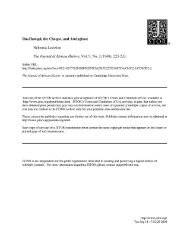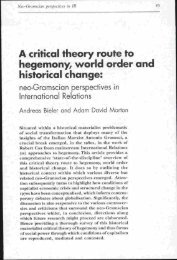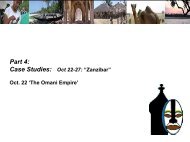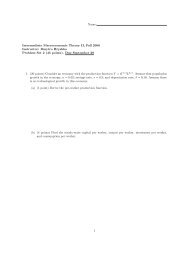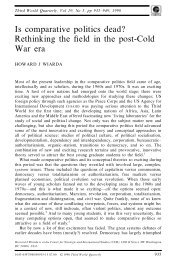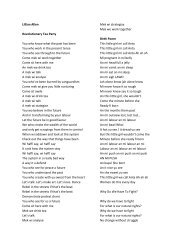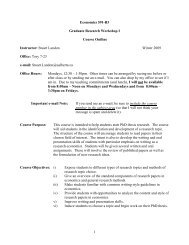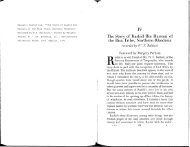personal memories revolutionary states and indian ocean migrations
personal memories revolutionary states and indian ocean migrations
personal memories revolutionary states and indian ocean migrations
Create successful ePaper yourself
Turn your PDF publications into a flip-book with our unique Google optimized e-Paper software.
The Salafiyya movement led by Jamāl al-Dīn al-Afghānī, Muḥammad<br />
‘Abduh <strong>and</strong> Rashīd Riḍā, with its advocacy for Islamic reform <strong>and</strong> unity, made its<br />
way into Zanzibar in the late nineteenth century <strong>and</strong> appealed to many members of<br />
the Omani elite. According to Muḥsin al-Barwānī, Sayyid Manṣab Abū Bakr bin<br />
Sālim (1863-1927) was in direct contact with Rashīd Riḍā <strong>and</strong> his movement in<br />
Egypt. Another member who came under the influence of the Salafi ideology was<br />
‘Īsa bin ‘Alī, al-Barwānī’s uncle, described by his nephew ‘as religious but with a<br />
secular approach’. 40 He kept photos of Muḥammad ‘Abduh <strong>and</strong> al-Afghānī <strong>and</strong><br />
read al-Manār, which was already known to a number of Zanzibaris, including their<br />
Sultans, <strong>and</strong> was probably found in the library of the Arab Association. 41 Moreover,<br />
there were a number of Egyptians residing in Zanzibar since the late nineteenth<br />
century <strong>and</strong> they were known for their sympathies to modernist Islam. One of them<br />
was Muḥammad Luṭfī, a supporter of Salafi views that he discussed with young<br />
Zanzibaris in the Jum`a mosque in Zanzibar. 42<br />
The Sultans themselves were not isolated from those Salafi currents <strong>and</strong><br />
more important, they seem to have been known for their openness towards them.<br />
This prompted some pioneers of the Salafiyya movement to contact the Sultans <strong>and</strong><br />
ask for financial assistance to help run their journals. Rashīd Riḍā, editor of al-<br />
Manār, was one of those who contacted Sultan Ḥamūd asking for such assistance. 43<br />
Further evidence of the Zanzibari Sultans’ reputation as supporters <strong>and</strong> sponsors of<br />
religious movements <strong>and</strong> scholars was a letter sent from the manager of al-‘Urwa al-<br />
Wuthqā seeking financial aid. 44<br />
This relationship with the Salafiyya movement seemed to have taken a new<br />
turn when Nāṣir al-Lamkī, a prominent member of the Omani elite <strong>and</strong> a wealthy<br />
l<strong>and</strong>lord, visited Egypt some time between 1900 <strong>and</strong> 1901, <strong>and</strong> met with some of<br />
Muḥammad ‘Abduh’s pupils, <strong>and</strong> more significantly with ‘Abd al-Raḥmān al-<br />
Kawākibī. 45 It is also said that al-Lamkī had the chance to discuss with al-Kawākibī<br />
some of his ideas in Ṭabā‘i’ al-istibdād, excerpts of which al-Lamkī had probably read<br />
in al-Mu’ayyad, also circulating in Zanzibar <strong>and</strong> with which al-Lamkī used to<br />
correspond. 46 This meeting between al-Lamkī <strong>and</strong> al-Kawākibī might have intrigued<br />
the latter to visit Zanzibar <strong>and</strong> the East African coast in 1901 <strong>and</strong> the opportunity<br />
<strong>and</strong> funding to do so might have been provided by the pan-Islamist Khedive<br />
‘Abbās II of Egypt. 47<br />
The imprint of the Salafiyya movement on Omani intellectual <strong>and</strong> political<br />
life in Zanzibar was seen in the publication of the first Arabic newspaper, al-Najāḥ,<br />
edited by al-Lamkī <strong>and</strong> al-Bahlānī between 1910 <strong>and</strong> 1914. It served as the<br />
mouthpiece of a party they established called al-Iṣlāḥ. 48 Al-Najāḥ was molded, in<br />
terms of content, in a fashion similar to al-Manār’s. The only surviving volume<br />
indicates that it had a pan-Islamic tone <strong>and</strong> a pro-reform agenda. 49<br />
OTTOMANISM VERSUS COLONIALISM:<br />
THE OMANI ELITE AND PAN-ISLAMISM<br />
The Ottoman court, during what is known as the Hamidien era (1876-<br />
1909), cultivated the ideology of pan-Islamism for two main purposes. One was to<br />
curb the influence of nationalist movements threatening the unity of the Ottoman<br />
Empire <strong>and</strong> the other to intimidate European colonial powers ruling over Muslim<br />
communities. Ottoman pan-Islamism had much resonance in the Muslim world,<br />
http://web.mit.edu/cis/www/mitejmes/<br />
49



